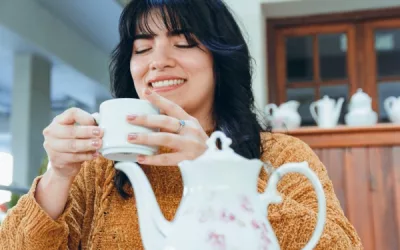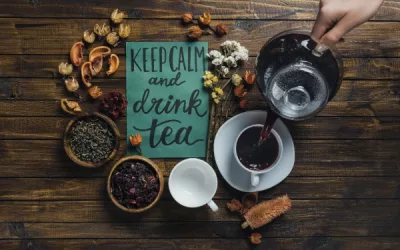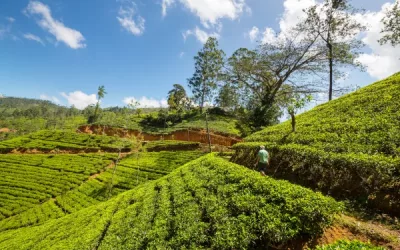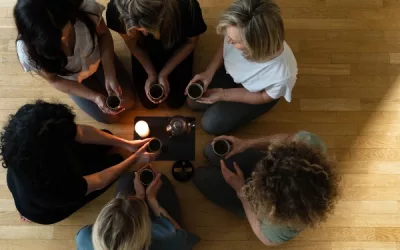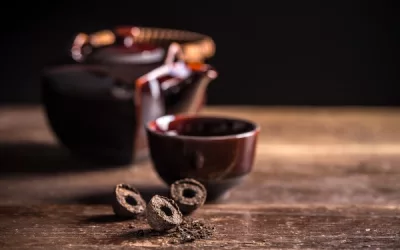Did you know that tea is the second most consumed beverage in the world, right after water? Whether you’re a seasoned tea enthusiast or just curious about this ancient drink, understanding the diverse types of tea can elevate your experience. This article explores the various categories of tea, their unique benefits, and how they can fit into your lifestyle. From refreshing green teas to robust black brews, discover the flavours, health advantages, and cultural significance of tea, helping you choose the perfect cup for any occasion.
Table of Content
- What are the main categories of tea?
- How do the health benefits vary among tea types?
- What is the difference between black and green tea?
- What are the unique characteristics of Oolong tea?
- How does the production process affect tea quality?
- What are herbal teas and how do they differ from traditional teas?
- How can one choose the right type of tea for personal preferences?
- What cultural significance does tea hold around the world?
- Conclusion
What are the main categories of tea?
When it comes to tea, there are six main categories that you’d want to get familiar with: Black, Green, White, Oolong, Yellow, and Pu-erh. Each category has its own unique processing methods, flavor profiles, and origins. Understanding these can help you appreciate the rich diversity that tea offers.
Tea classifications originate from how the leaves of the Camellia sinensis plant are processed. From the robust and full-bodied Black tea to the delicate and subtle White tea, each type has a distinct character that sets it apart.
What defines each category of tea?
Each tea category is defined by its processing method and flavor profile. Here’s a rundown:
- Black Tea:
- Processed through full oxidation, giving it a dark color.
- Known for a strong, bold flavour.
- Origins: China and India, particularly Assam, Darjeeling, and Ceylon regions.
- Green Tea:
- Minimal oxidation; processed by steaming or pan-frying quickly after picking.
- Light, fresh taste with grassy or vegetal notes.
- Origins: Predominantly China and Japan.
- White Tea:
- Least processed; just withered and dried.
- Delicate, light flavour with a hint of sweetness.
- Origins: Fujian province in China.
- Oolong Tea:
- Partially oxidised; oxidation level can vary greatly.
- Combines characteristics of both Black and Green teas, with floral and fruity notes.
- Origins: China and Taiwan.
- Yellow Tea:
- Similar to Green tea but undergoes a slower drying phase.
- Mild, fruity flavour with a yellowish colour.
- Origins: China, lesser-known and rare.
- Pu-erh Tea:
- Fermented and aged, often for many years.
- Earthy, rich flavour that deepens with age.
- Origins: Yunnan province in China.
How does the processing method affect the flavor?
The way tea leaves are processed greatly affects their flavour and aroma. Let’s break it down:
- Black Tea:
- Full oxidation transforms the leaves, delivering robust and malty flavours.
- Can be enjoyed with milk and sugar due to its strong profile.
- Green Tea:
- Minimal oxidation preserves fresh, grassy aromas and some astringency.
- Pairs well with lighter foods like fish and salads.
- White Tea:
- Minimal processing keeps a naturally sweet and delicate taste.
- Best appreciated on its own due to its subtlety.
- Oolong Tea:
- Varied oxidation levels result in a complex mix of floral and fruity profiles.
- Can be steeped multiple times, each infusion revealing new flavours.
- Yellow Tea:
- The additional drying stage mellows the flavour, striking a balance between Green and White teas.
- Offers a smoother experience.
- Pu-erh Tea:
- Fermentation and aging process creates deep, earthy tones, often likened to wine in complexity.
- Best sipped slowly to appreciate its evolving taste.
What are the historical origins of these tea categories?
Tea has a rich history spanning thousands of years. Here’s a glimpse into the origins of the major tea types:
- Black Tea:
- Developed during the Ming Dynasty in China, it later spread to India and Sri Lanka under British influence.
- Green Tea:
- One of the oldest types of tea, dating back to more than 4,000 years in China.
- Highly celebrated in Japanese tea ceremonies.
- White Tea:
- Originated in Fujian province, China, during the Tang Dynasty.
- Known historically as a royal tea.
- Oolong Tea:
- Originated in the Fujian province of China during the Qing Dynasty.
- Gained cultural significance in Taiwan.
- Yellow Tea:
- Rare and mostly consumed by Chinese emperors.
- Developed during the Ming Dynasty.
- Pu-erh Tea:
- Dates back to the Tang Dynasty in Yunnan, China.
- Traditionally used for trade due to its long shelf life.
Centuries ago in the 8th century, Lu Yu, the famed Chinese tea master, documented tea culture in “The Classic of Tea,” the first known tea book. His work captured the essence and intricate nature of tea preparation, influencing tea cultivation and consumption for generations. This book remains a seminal reference for tea enthusiasts around the globe.
Years ago, I went on a tea-tasting journey in China. Visiting a remote village in the Fujian province, an elderly tea master invited me to his home. The aroma of freshly brewed White tea filled the air. Sipping the delicate brew while hearing his stories about tea’s history was a surreal experience. It felt like stepping back in time. That trip deepened my appreciation for the subtleties and breadth of this ancient beverage.
How do the health benefits vary among tea types?
When diving into the world of tea, you’ll discover a spectrum of health rewards. The tea you choose can help in various ways, ranging from antioxidant boosts to promoting relaxation. Each tea offers unique advantages.
By using the table below, you can identify which tea type aligns with your health goals. The first column explains the health benefit, the second lists the teas that offer that benefit, and the third details the possible effects. This allows you to tailor your tea selection to your needs.
| Health Benefit | Associated Tea Types | Potential Effects |
|---|---|---|
| High Antioxidants | Green tea, White tea, Oolong tea | May reduce inflammation and support skin health |
| Weight Loss | Green tea, Oolong tea | Can boost metabolism and help in fat burning |
| Calmness and Relaxation | Chamomile tea, Peppermint tea | May reduce stress and promote better sleep |
| Digestive Health | Ginger tea, Peppermint tea | Can soothe the stomach and alleviate bloating |
| Immunity Boost | Echinacea tea, Elderberry tea | May enhance immune system function |
| Mental Clarity | Green tea, Ginkgo biloba tea | Can improve focus and cognitive function |
| Low Caffeine | Rooibos tea, Herbal teas | Safe alternative for those avoiding caffeine |
To use the table, identify your desired health benefit, then find a suitable tea from the second column. Lastly, check the potential effects to understand what you might expect.
What are the antioxidant benefits of green tea?
Green tea has a high concentration of antioxidants, particularly catechins, which may bring various health benefits.
- Rich in catechins: These are natural antioxidants that help prevent cell damage.
- May lower the risk of some cancers: Regular green tea consumption may lower risks for breast, prostate, and colorectal cancers.
- Supports cardiovascular health: Antioxidants in green tea may reduce cholesterol levels.
- Promotes skin health: Helps reduce wrinkles and signs of ageing.
Green tea, therefore, acts as a guard for your cells while providing additional health benefits.
How can drinking tea help with weight loss?
Many teas, especially green and oolong, are known for their metabolism-boosting properties, which can aid in weight loss.
- Boosts metabolic rate: Increases the number of calories burned.
- Enhances fat oxidation: Helps break down body fat.
- Natural diuretic: Can reduce water retention.
- Low-calorie beverage: Healthy alternative to sugary drinks or snacks.
Incorporating green or oolong tea into your daily routine can support your weight loss journey by boosting metabolism and burning fat.
Hundreds of years ago, Emperor Shennong of ancient China was known for his research into medicinal plants. He discovered the health benefits of tea when leaves from a wild tea tree blew into a pot of boiling water and created a fragrant liquid. He found that drinking this infused liquid alleviated many health issues, leading to tea becoming an integral part of Chinese culture and daily life.
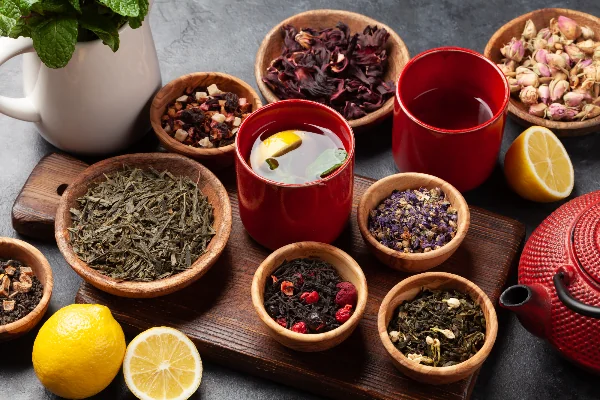
What is the difference between black and green tea?
Let’s spill the tea—quite literally—on how black and green tea differ. First off, it’s essential to know that they’re two sides of the same leaf. Both come from the Camellia sinensis plant. However, they diverge vastly in terms of processing methods, taste, and health benefits.
How are black and green tea processed differently?
Imagine black tea and green tea as coming from the same family, but taking different career paths. Black tea is like that sibling who goes through a rigorous corporate grind, while green tea is more of the nature-loving yogi.
Black tea undergoes full oxidation. The leaves are withered, rolled, and then exposed to air for an extended period. This causes the leaves to darken and enhance flavour complexity.
Green tea, on the other hand, is the minimalist in the family. It skips the oxidation stage, retaining its green hue. The leaves are quickly steamed or pan-fired right after being picked to prevent oxidation and preserve their natural green colour.
What are the key flavour differences?
So, you’re wondering what these teas would be like on your taste buds? Here’s the scoop.
- Black tea: Bold, robust, and sometimes malty or smoky. Expect a full-bodied experience. Think of English Breakfast or Assam.
- Green tea: Light, fresh, and slightly grassy. Its taste can vary from sweet to vegetal. Popular types include Sencha and Matcha.
- Scent: Black teas often carry a more intense aroma, whereas green teas are more subtle and fresh.
- Colour: Black tea brews to a rich, amber hue, while green tea often has a pale, yellow-green tint.
Black tea is like the strong, dependable type, while green tea is mild and refreshing—a sunny picnic compared to a formal dinner.
What distinct health benefits do they offer?
Now, let’s talk about why you might want to have one over the other apart from just taste.
- Black Tea:
- Antioxidants: Packs a punch with theaflavins and thearubigins.
- Heart Health: Studies suggest it might improve blood pressure.
- Energy Boost: Black tea is often higher in caffeine, giving you a good kick start.
- Gut Health: It supports good bacteria in your gut.
- Green Tea:
- EGCG: Loaded with this antioxidant that’s been the darling of many health studies.
- Weight Loss: Often touted for its fat-burning properties.
- Brain Health: Might improve brain function and lower the risk of neurodegenerative issues.
- Anti-aging: It’s like a time machine for your cells thanks to its high antioxidant content.
So, sip some black tea if you need a strong morning boost. Opt for green tea if you’re looking to zen out while feeling virtuous about those health benefits.
Long before the East India Company started making Brits obsessed with tea, the Chinese had already elevated it to an art form. Emperor Shen Nong, or “Divine Farmer,” is said to have discovered tea when leaves from a wild tree blew into his pot of boiling water. This serendipitous event supposedly happened in 2737 BCE. It’s fascinating to think that a simple breeze could change the course of beverage history, giving us both black and green tea to savour centuries later. Cheers to accidental greatness!
What are the unique characteristics of Oolong tea?
Oolong tea, the rebellious middle child of the tea world, doesn’t really conform to the neat categories of black or green tea. It’s partially oxidised, meaning it undergoes a process that’s half-heartedly between green tea’s minimal oxidation and black tea’s full-blown transformation. This middle-ground process gives Oolong its eclectic personality – resulting in a wide array of flavours that can range from fruity and sweet to woody and roasted. It’s like a party in your mouth, and everyone’s invited!
But let’s not get too carried away by the sensory overload. The origins of Oolong tea trace back to China’s Fujian province, but its popularity has spread to Taiwan and beyond. Whether you’re sipping a cup of Tie Guan Yin or Dong Ding, each type has its own storytelling flair, kind of like that peculiar uncle at family gatherings.
Oolong tea isn’t just about playing mixologist with your taste buds; it’s also known for health perks and a long-standing tradition that whispers tales of ancient emperors and skilled tea masters. So, buckle up as we dive deeper into what makes Oolong tea the maverick it is.
What makes Oolong tea different from other types?
Being neither fully green nor black, Oolong tea exists in a glorious in-between zone. The semi-oxidation process it undergoes varies from 10% to 80%, giving it its unique flavour profile. Here’s how this semi-oxidation sets Oolong apart:
- Diverse Flavours: Depending on how much it’s oxidised, Oolong can hit your palate with floral notes, fruity undertones, or even a roasted, woody depth. Imagine the spectrum from delicate Jasmine to robust Darjeeling, but all under one tea umbrella.
- Skilled Crafting: Making Oolong is no Jenga game. Tea artisans meticulously control the oxidation process, monitoring factors like temperature and humidity. It’s practically a science lab up there!
- Appearance: Oolong leaves are often twisted or curled, unlike the straight needles of green tea or the small, broken pieces of black tea.
- Brewing Flexibility: Oolong gives you the VIP treatment – it can be re-steeped multiple times without losing its essence, unlike some other teas that wimp out after the first round.
Essentially, Oolong’s semi-oxidation process is what makes it the Swiss Army knife of teas, offering a range of experiences all in one leaf.
What are some notable Oolong tea varieties?
With so many flavours packed into Oolong tea, it’s only fair we give a shoutout to its rockstars:
- Tie Guan Yin (Iron Goddess of Mercy): This floral-heavy Oolong hails from Fujian and is known for its fragrant aroma and smooth, orchid-like taste.
- Da Hong Pao (Big Red Robe): A Tea with a title! Its roasted, robust flavour makes it a favourite amongst the elite and is often dubbed a ‘rock tea’ due to the mountainous region it’s grown in.
- Dong Ding (Frozen Summit): A medium-oxidised offering from Taiwan, famous for its slightly creamy, nutty flavour.
- Oriental Beauty (Bai Hao Oolong): This flashy number is sweet and fruity, with a distinct hint of honey, earning it the nickname “Champagne Oolong.”
These varieties prove that Oolong isn’t just a tea; it’s an entire playlist of melodies and moods.
Oolong tea isn’t just good for making your taste buds do the cha-cha; it’s got a few tricks up its sleeve in the health department too.
How does Oolong tea benefit health?
Oolong tea doesn’t just stop at being tasty; it’s also got health benefits that make it practically a wellness potion. From helping you burn fat to keeping your heart tick-tocking smoothly, here’s why you might want to add Oolong to your daily routine:
- Metabolism Booster: Thanks to its moderate caffeine content, Oolong can give your metabolism a gentle kick in the pants, assisting in weight management.
- Antioxidants Galore: Comparable to green tea, Oolong is packed with polyphenols, which fight off the usual suspects like free radicals and inflammation.
- Heart Health: Regular consumption can help reduce the risk of cardiovascular diseases by lowering bad cholesterol levels.
- Mind Sharpener: The combo of caffeine and L-theanine in Oolong boosts brain function, helping you stay alert and focused without the jitters.
- Skin Saver: Those antioxidants again! Oolong’s rich profile helps in keeping your skin radiant and wrinkle-free.
In essence, sipping on Oolong tea is like giving your body a little spa day, while you gossip over the latest family drama and enjoy the aromatic brew.
During the Tang Dynasty in China (618–907 CE), Oolong tea was exclusively reserved for the emperor and his court, like Beyoncé tickets if she lived in ancient China. Skilled tea artisans would present the freshly crafted Oolong to the emperor, ensuring its quality was worth royal approval.
Legends even tell of an emperor who was so enchanted by the tea’s taste that he granted the tea master a plot of land called ‘Tie Guan Yin,’ named after one of Oolong’s most revered varieties. This origin story isn’t just a marketing gimmick – it’s a testament to the centuries-old craftsmanship and care that goes into every cup of Oolong.
So, the next time you sip on a delicate floral Oolong or a robust roasted one, remember you’re partaking in a royal tradition that’s stood the test of time.
How does the production process affect tea quality?
When it comes to savouring that perfect cup of tea, it’s not just about picking leaves and pouring hot water. Oh no, my friend, it’s way more intricate. The production process is like a culinary orchestra, where climate, soil, and processing methods play the lead roles, and any misstep can turn your symphony into a tragic cacophony. Let’s break this down, shall we?
The journey of tea from leaf to cup is influenced by numerous factors. Everything from the weather, the earth, and how the leaves are handled impacts the flavour and aroma. So, if you’re yearning for that divine brew, pay attention, because each step in the process can make or break your tea experience.
What role does climate play in tea production?
Believe it or not, Mother Nature has quite the say in how your tea tastes. You’d think tea plants are just happy to grow anywhere, but they’re rather picky. Climate makes a massive difference.
- Sunlight: A good dose of sunshine helps in the development of essential oils, contributing to the tea’s aroma.
- Altitude: Higher elevations result in slower-growing tea plants, which equates to richer flavours and aromas.
- Rainfall: Consistent, moderate rainfall helps the plants thrive without being waterlogged.
- Temperature: Extreme temperatures can stress the plants, but a balanced range allows for better growth and quality.
- Seasonal Variations: Different harvesting seasons result in unique flavour profiles, with spring and autumn often yielding the best quality.
So, the next time you’re sipping an exquisite Darjeeling, remember that it’s the cool, misty hills of the Himalayas infusing your cup with magic.
How does soil quality affect tea flavour?
Just like an artist needs a good canvas, tea plants need quality soil to shine. Soil quality can make or break the flavour of your brew.
- Nutrient Composition: Rich soils full of organic material provide essential nutrients, resulting in robust and complex flavours.
- pH Levels: Slightly acidic soils (pH level around 5.5 to 6.5) are perfect for tea plants, ensuring they absorb nutrients efficiently.
- Drainage: Well-drained soils prevent root rot, essential for healthy plant growth.
- Mineral Content: Unique minerals in the soil can impart distinctive flavours to the tea, like the sweet and earthy notes in Pu-erh tea.
- Texture: The soil texture affects root expansion and water absorption, which in turn impacts plant health and flavour development.
The unique taste of Assam tea? That’s thanks to the fertile and well-drained alluvial soils of the Brahmaputra Valley.
Why is processing method crucial for tea quality?
You can have the best climate and soil, but if the processing is botched, you might as well toss those leaves in the bin. Processing is the make-or-break stage.
- Withering: Reduces water content and prepares the leaves for further processing.
- Rolling: Breaks the leaf cells, releasing essential oils that define the tea’s aroma.
- Oxidation: Determines the tea type (black, green, oolong, etc.). Carefully controlled oxidation impacts flavour and colour.
- Firing/Drying: Stops oxidation and locks in flavour, preventing spoilage and promoting longevity.
- Sorting and Grading: Ensures uniformity, with higher grades generally offering superior flavours.
Ever wondered why matcha is so vivid and tastes divine? It’s because of meticulous shading, handpicking, steaming, and grinding processes. The Japanese don’t mess around.
In the 1840s, during British colonial rule in India, Scottish adventurer Robert Bruce stumbled upon wild tea plants in Assam. Fascinated, he realised these plants could rival the Chinese teas that were all the rage back in Europe. Despite rough terrains and initial failures, Bruce persisted. His discovery led to the establishment of the Assamese tea industry, which remains a powerhouse today. Thanks to his persistence, you can enjoy that strong, malty Assam tea with a newfound appreciation. Cheers to Bruce for his stubborn determination!
What are herbal teas and how do they differ from traditional teas?
Herbal teas, my dear reader, are the rebels of the tea world. They don’t come from the Camellia sinensis plant, the source of traditional teas like black, green, and oolong. Instead, they’re an infusion or “tisane” of herbs, fruits, flowers, or spices. It’s like the difference between a classic superhero and an anti-hero in the comics – both are cool, but they play by different rules.
So, how are these herbal concoctions brewed? Simple – toss your dried or fresh goodies into hot water, let them mingle for a bit, strain, and voilà! You’ve got yourself a cup of hot relaxation or an energy boost, depending on what you’ve picked. In contrast, traditional tea requires specific temperatures and steeping times to avoid turning your cup into a bitter mess.
Examples of popular herbal teas include peppermint, which is great for soothing tummy troubles, and chamomile, your bedtime buddy. We’ve also got rooibos, a caffeine-free alternative packed with antioxidants. Unlike traditional teas loaded with caffeine, these herbal delights are often caffeine-free and serve different purposes like alleviating stress or improving digestion.
What defines herbal teas?
Herbal teas are defined by what they’re not. They’re not made from tea leaves. Instead, they can include:
- Flowers: Think chamomile, hibiscus, and lavender.
- Herbs: Peppermint, lemongrass, and basil.
- Fruits: Citrus peels, apples, and berries.
- Spices: Ginger, cinnamon, and cardamom.
Herbal teas are super versatile and bursting with unique flavours and aromas, unlike traditional teas which generally have a more uniform taste profile. They have a long history, often tied to medicinal uses, going back to ancient civilisations like the Egyptians and the Chinese. Even the flavours you get from herbal teas can be more adventurous and varied compared to the often subtle notes of traditional teas.
How are herbal teas prepared?
Preparing herbal teas is a piece of cake – no PhD in culinary arts required!
- Boil water: Start with fresh water for a clean taste.
- Add herbs: Use 1-2 teaspoons of dried herbs or a handful of fresh herbs per cup.
- Steep: Let the herbs soak in the hot water for about 5-15 minutes.
- Strain: Remove the herbs using a strainer or infuser.
- Enjoy: Sip and savour the flavours, maybe add honey if you’re feeling fancy.
Unlike traditional teas that demand a specific temperature to avoid bitterness (think green tea), herbal teas are a lot more forgiving. You want to soak rooibos for 10 minutes? Go for it. Steeping peppermint for 5 minutes? That’s cool too. You’re in the driver’s seat!
What are the benefits of drinking herbal teas?
Herbal teas come with a treasure trove of benefits that can make you wonder why you ever settled for plain old water.
- Calming effects: Chamomile and lavender can help you unwind.
- Digestive aid: Peppermint and ginger can soothe upset stomachs.
- Antioxidants galore: Rooibos and hibiscus are packed with antioxidants to fight off those pesky free radicals.
- Caffeine-free: Perfect for those who want to avoid the jitters that come with traditional teas.
- Hydration: Herbal teas are a tasty way to up your water intake.
On top of all this, they can provide relief from common ailments like colds, headaches, and insomnia. And hey, they also taste great, so you’re getting a delicious drink plus a health boost.
During a peaceful morning in 5th-century BCE China, Emperor Shen Nong was boiling water to drink when leaves from a nearby tree blew into his pot. Intrigued, he tasted the accidental brew and found it refreshing. This happy accident is said to have marked the birth of tea drinking in Chinese culture. If it wasn’t for Shen Nong’s serendipitous discovery, we might never have embarked on this marvellous journey of exploring all the wonderful teas we enjoy today. Here’s to happy accidents and discovering new blends!
How can one choose the right type of tea for personal preferences?
Selecting the perfect tea for your taste buds can be like finding a needle in a haystack—or better yet, finding the TV remote when you’re hungry and your favourite show is about to start. But fear not, my intrepid tea explorer! Choosing the right brew is simpler than you might think if you consider your preferences, health goals, and the occasion. Let’s untangle this web of tea varieties and zero in on what makes your cup runneth over with joy.
Gathering tips on how to choose tea based on your individual preferences, health goals, and the occasion is not only important, it’s downright useful! You might not be an expert yet, but here’s the thing: tea experimentation brings endless possibilities.
What factors should be considered when choosing tea?
Choosing a type of tea shouldn’t feel like quantum physics. Here are some key factors to help guide your selection:
- Taste Preference: Black, green, oolong, white, and herbal teas each have unique flavour profiles. Think of the taste spectrum from sweet to bitter, strong to delicate.
- Health Benefits: Green teas are packed with antioxidants; herbal teas, like chamomile, can help with relaxation; oolong aids in digestion. Match your health goals with the tea’s benefits.
- Caffeine Content: Do you need a morning jolt, or are you looking for a soothing evening brew? Black teas will have you buzzing, while herbal teas will let you snooze.
- Occasion: Is it an afternoon tea party or a post-yoga wind down? Choose your tea to match the event. Earl Grey for sophistication; peppermint for refreshment.
- Personal Rituals: Some like it hot, others like it iced. Factor in how you enjoy your tea. A hot matcha latte might be your winter jam, while iced white tea is your summer fling.
Tea is like a chameleon; it adapts to your needs. Consider what you’re looking for and the choice becomes clear as day—or in this case, as clear as a well-brewed cup of chamomile.
How can one discover their preferred tea flavour?
The journey to finding your favourite tea is akin to dating—sometimes you kiss a few frogs before finding your prince. Here’s how to start:
- Tea Sampling Kits: These nifty kits offer a variety of teas in smaller quantities, allowing you to dive into diverse flavours without committing to a full box.
- Tea Tasting Events: Much like wine tastings (but classier and less likely to cause questionable decisions at 2 AM), these events can help you discern different nuances.
- Tea Shops & Cafes: Many spots offer tea by the cup, letting you sip various brews without buying bulk.
- Tea Subscriptions: These monthly deliveries serve up different teas to your doorstep, ensuring your taste buds embark on a continuous flavour journey.
- Talk to a Tea Sommelier: Yes, they exist. Think of them as your tea matchmaker, guiding you to that perfect match.
Embark on your tea quest with the enthusiasm of a toddler in a toy store. Sampling and tasting is half the fun, and it ensures you’ll land on a flavour that hits all the right notes.
What resources are available for tea selection?
In today’s world, there’s no shortage of resources to guide you on your tea adventures. Here’s where to get your feet wet (or should I say, cups steeped):
- Tea Blogs and Magazines: Publications like “Tea Time” and “The Tea Table” are brimming with insights, reviews, and recommendations.
- Online Forums: Websites like Reddit and TeaChat are great for exchanging ideas and gaining recommendations from fellow enthusiasts.
- Mobile Apps: Apps like “Teavana” and “Tea Taster” can help you log and review teas that tickle your fancy.
- YouTube Channels: Channels such as “The Tea House” and “Vahdam Teas” provide visual and informative content that’s big on detail and small on pretension.
- Books: Dive into classics like “The Tea Book” by Linda Gaylard and “The World Atlas of Tea” by Krisi Smith, for comprehensive guides.
Using these resources, you can become a tea connoisseur faster than you can say, “Earl Grey, hot.” It’s all about accessing the right information and surrounding yourself with fellow tea lovers.
In the early 1700s, tea was the superstar of social gatherings, especially in Britain. Take Lady Mary Wortley Montagu, a prolific letter writer, and socialite who transformed tea into a societal ritual. She frequently held tea parties where guests indulged in exotic imported teas, setting trends that continue to this day.
So, when you sip your chosen brew, remember you’re partaking in a tradition with a rich history carried forth by enthusiasts just like you.
What cultural significance does tea hold around the world?
Tea isn’t just a drink; it’s practically a universal language. The cultural significance of tea varies dramatically around the world, influencing social rituals, traditions, and even national identities. If you think your morning cup of brew is simple, you’ll be amazed at how it ties into centuries-old customs.
Tea has found its way into the tapestry of daily life across continents, affecting everything from formal ceremonies in Japan to casual afternoon breaks in England. Let’s dive into the rich cultural waters of tea to get a sense of its importance.
How is tea celebrated in different cultures?
If you thought family dinners were complicated, you clearly haven’t tried joining in on a traditional tea ceremony. Each culture has its unique way of celebrating tea, and these customs can tell you a lot about the society itself.
- Japan: In Japan, tea takes on a meditative quality. The Japanese tea ceremony, or “chanoyu,” is a choreographed ritual of preparing and consuming matcha (powdered green tea). It’s less about quenching your thirst and more about the aesthetic, preparation, and serving process. Here, the ceremony is an art form, rooted in Zen Buddhism and centred around mindfulness.
- China: The Chinese culture has a rich history with tea, believed to have begun with Emperor Shen Nong in 2737 B.C. Tea is often served formally to guests, symbolising respect and hospitality. The “Gongfu Cha” ceremony involves a meticulous preparation process that emphasises flavour and experience.
- United Kingdom: Ah, the land of afternoon tea. This tradition started in the early 19th century, thanks to Anna, the Duchess of Bedford. The British habitually enjoy their tea with finger sandwiches, scones, and an assortment of pastries. Afternoon tea is more of a social event, often held in grand hotels or tea rooms.
- India: Indians are practically married to their chai. Street vendors (chai wallahs) brewing masala chai on almost every corner is a common sight. A mixture of black tea, milk, sugar, and spices, chai is more than just a drink; it’s a daily ritual ingrained in Indian culture.
- Morocco: Moroccan tea customs are a blend of Arab and Berber traditions. Mint tea, also known as “Atay,” is a symbol of hospitality and friendship. Served in beautiful silver teapots and poured into small glasses from a height to create a frothy “head,” it’s all about showing respect to guests.
What are some traditional tea ceremonies?
If there’s one thing that can bring people together, it’s a good tea ceremony. These rituals aren’t just about brewing tea; they’re a way to connect and honour tradition.
- Japanese Tea Ceremony (Chanoyu): A balance of aesthetics, utensils, and behaviour. Involves steps like purifying the tea scoop, whisking matcha, and appreciating each item’s craftsmanship.
- Chinese Gongfu Tea Ceremony: Precision in every step, from boiling water to brewing multiple infusions. Uses small teapots and cups to appreciate aroma and flavour.
- Korean Darye: Simpler than the Japanese counterpart, focusing on ease and naturalness. Typically uses green tea and emphasises harmony.
- Moroccan Mint Tea Serving: Pouring from a height for frothy finish. Reflects hospitality and is usually accompanied by sweets.
- Taiwanese Tea Ceremony: Involves oolong teas and highlights aroma, often using “scent cups.”
These ceremonies share a common thread: respect for the process and the people involved. Each step, from preparing the tea to serving it, is an act of mindfulness and honour.
When it comes to social interactions, tea is practically the ultimate icebreaker. It’s not just about drinking but about fostering conversations and connections.
- Networking: Think about British afternoon tea. It’s a chance for people to chat and get to know each other in a relaxed setting.
- Hospitality: In many cultures, offering tea to guests is a gesture of respect and hospitality. From serving “chai” in India to mint tea in Morocco.
- Ceremony: Japanese and Chinese tea ceremonies are deeply embedded in cultural customs. They focus on the interaction between host and guest.
- Family bonding: In countries like Turkey and Egypt, tea is part of family gatherings. Sharing a pot of strong black tea keeps the conversation flowing.
- Business: In many Asian cultures, tea is integral to business meetings. A well-brewed cup can set the tone for negotiations.
Tea isn’t just a comforting beverage; it’s a social lubricant. Whether you’re at a high-stakes business meeting or a casual family gathering, a pot of tea often acts as the glue that keeps interactions smooth and pleasant.
Tea has played such a significant role in history that wars have been fought over it. Speaking of historical tea tales, let’s rewind to the Boston Tea Party in 1773. Fed up with British taxes, American colonists dressed as Mohawk Indians and dumped tonnes of tea into Boston Harbour.
This rebellious act was one of the sparks that ignited the American Revolution. Just imagine the gallons of tea that went to waste! But hey, it paved the way for the birth of a nation that ironically doesn’t hold tea in the same regard as the Brits. There’s a historical anecdote that’s worth a sip, don’t you think?
Conclusion
As I reflect on the intricate world of tea, it’s clear that this versatile beverage transcends mere enjoyment. Throughout this guide, we’ve explored the six primary categories of tea—Black, Green, White, Oolong, Yellow, and Pu-erh—each defined by its unique processing methods, flavour profiles, and historical origins. Understanding these distinctions not only enhances our appreciation for tea but also invites us to consider its rich tapestry of flavours and aromas.
The health benefits associated with different types of tea are equally compelling, from the antioxidant properties of Green tea to the weight-loss potential of Oolong. As shown in the table, each tea type offers its unique advantages, suggesting that our choices can have a genuine impact on our well-being. Recognising this empowers us to make informed decisions in our daily lives.
Moreover, the differences between Black and Green tea highlight how processing methods significantly influence flavour and health benefits, while Oolong tea presents a captivating array of semi-oxidised flavours that reflect both tradition and innovation. These insights remind us that the journey of tea is steeped in complexity, shaped by factors such as climate, soil, and processing techniques—elements that ultimately serve as the backbone of tea quality.
As we navigate the world of herbal teas, it’s fascinating to note how they diverge from traditional teas, offering new realms of flavour and health benefits. Whether you’re in search of relaxation or a touch of invigoration, there’s an herbal infusion waiting to be discovered.
Choosing the right tea might feel daunting at first, but it’s a delightful journey of personal exploration. Each sip invites you to consider your own preferences, goals, and the occasions that call for a comforting brew. By experimenting and exploring, we not only refine our tastes but also deepen our connection to this ancient beverage.
Finally, as we traverse various cultures, the universal significance of tea becomes apparent—it’s a bridge between generations and a catalyst for connection. From ceremonial practices to daily rituals, tea beautifully illustrates how a simple cup can unite us across vast distances and differing traditions.
As you reflect on your own tea journey, consider this: what stories or moments might your next cup of tea invite into your life? In the words of the famous tea enthusiast, Ernest Hemingway, “There is no friend as loyal as a book, and no company as good as your cup of tea.” So, let’s pour ourselves a cup, embrace the knowledge we’ve gained, and perhaps even create our own stories in the process.
Resources
- Multifunctional health-promoting effects of oolong tea and its products
- Chemistry and health beneficial effects of oolong tea and theasinensins
- Phenolic Profiles and Antioxidant Activities of 30 Tea Infusions from Green, Black, Oolong, White, Yellow and Dark Teas
- Beneficial effects of green tea: A literature review
- Health Benefits of Tea – Herbal Medicine
- Tea and Health: Studies in Humans



